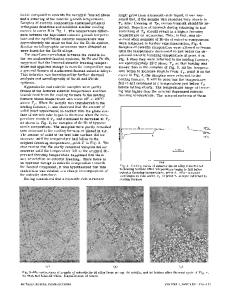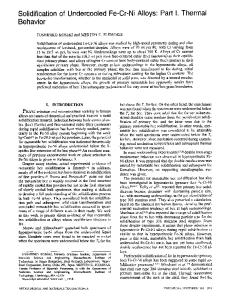Solidification of highly undercooled Fe-P alloys
- PDF / 1,671,415 Bytes
- 8 Pages / 612 x 792 pts (letter) Page_size
- 28 Downloads / 374 Views
I.
INTRODUCTION
S T U D Y of solidification behavior of undercooled bulk melts is of fundamental interest in itself and in better understanding rapid solidification processes. A major problem, studied theoretically and experimentally for some decades, has been the relation among dendrite tip radius, undercooling, and tip velocity. Lipton, Glicksman, and Kurz (LGK) m presented a model which couples a solution for thermal and solute diffusion fields around a dendrite tip (the Ivantsov solution t21) with a morphological stability criterion. E3j The Ivantsov solution assumes that the shape of a dendrite tip growing at steady state is approximated as a paraboloid of revolution with a fixed tip radius. The Ivantsov solution yields a result containing the product of dendrite tip velocity and radius. In order to determine the dendrite tip velocity and radius, the marginal (morphological) stability criterion is used. This stability criterion assumes that the dendrite tip grows at the limit of stability, and so the dendrite tip radius is equal to the wavelength of the shortest unstable perturbation of a planar front. Lipton, Kurz, and Trivedi (the "LKT model") t4~ extended the LGK model to large undercooling by assuming that the stability parameters become functions of the thermal and solutal Peclet numbers. Wu e t a l . I51 showed that experimental results of dendrite tip velocity v s bulk undercooling for Ni-25 pct Sn alloy agreed well with the LKT model. The foregoing models include the assumption of local equilibrium at the interface. In order to treat a nonequilibrium interface condition (solute trapping[6,7]), a more recent model by Boettinger, Coriell, and Trivedi (the "BCT model") fs~ incorporated the Ivantsov solution for the diffusion fields, the shortest marginally unstable
M. SUZUKI, Assistant Manager, is with the Material Research and Development Department, Toyota Motor Corporation, Toyota City, Japan. T.J. PICCONE, Postdoctoral Associate, and M.C. FLEMINGS, Professor and Department Head, are with the Department of Materials Science and Engineering, Massachusetts Institute of Technology, Cambridge, MA 02139. H.D. BRODY, Visiting Professor, Massachusetts Institute of Technology, is permanently affiliated with the Department of Metallurgical and Materials Engineering, University of Pittsburgh, Pittsburgh, PA 15261. Manuscript submitted September 26, 1990. METALLURGICAL TRANSACTIONS A
wavelength for determining the dendrite tip radius, a growth rate-dependent solute distribution coefficient, ~6j and a free energy change for crystallization related to the growth rate. In this article, we present experimental results on dendritic growth of Fe-P alloys and interpret them using a modified Boettinger, Coriell, and Trivedi (BCT) model. II.
EXPERIMENTAL PROCEDURE
Samples of iron-phosphorus alloy were prepared by high-frequency induction melting of iron pieces (purity 99.98 pct) and iron phosphide (Fe2P) particles (purity 99.9 pct) within a borosilicate glass medium under argon atmosphere. Sample mass was 3.2 g (about
Data Loading...










